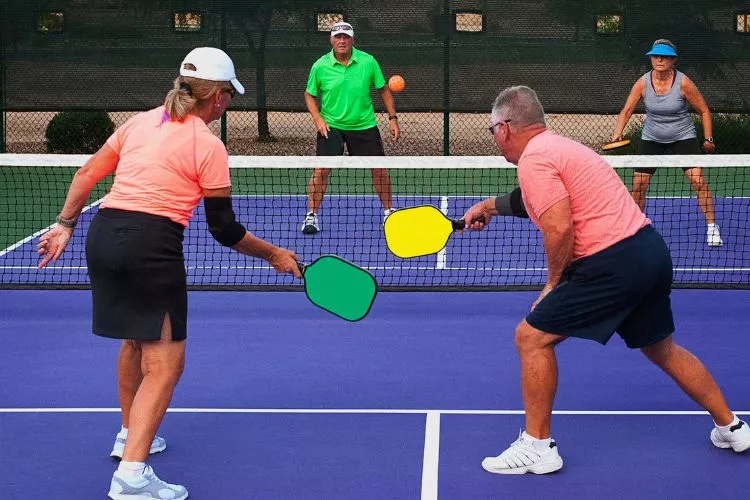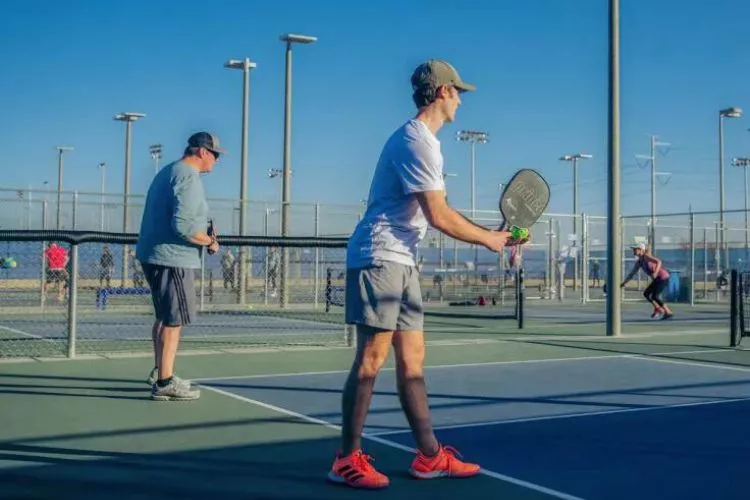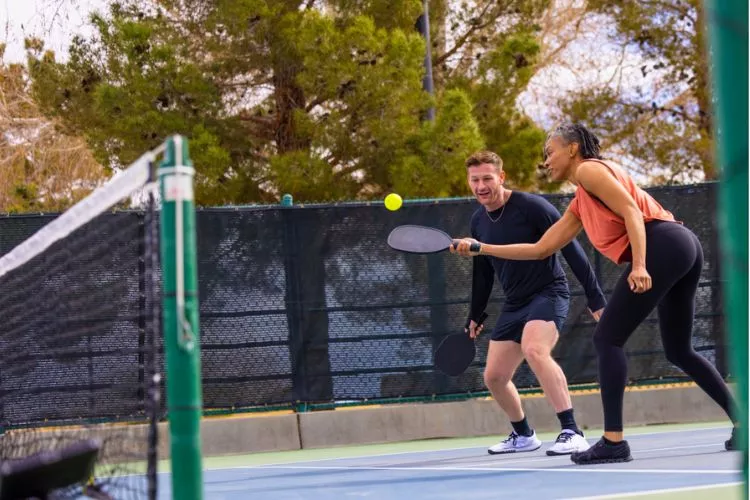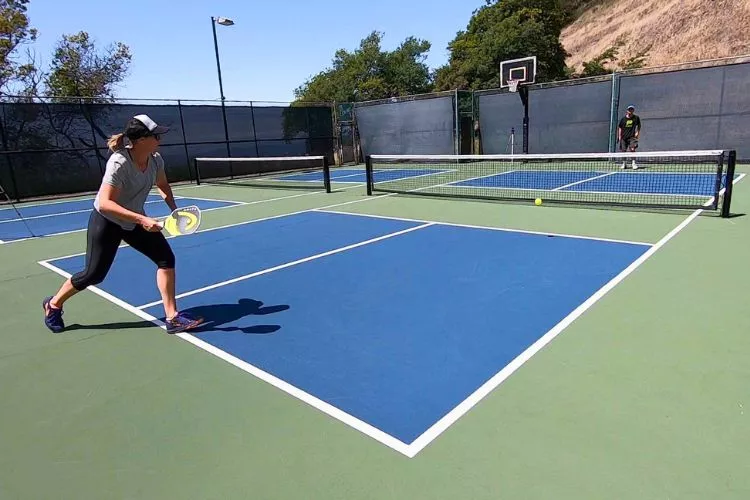Navigate the thrilling game of pickleball with ease as we dive into the specifics of its rulebook.
In this comprehensive guide, we’ll focus on two vital aspects often misunderstood – Fault and Let rules in pickleball.

We’ll demystify what they entail, how they affect gameplay, and why they are exceptionally crucial for every player, whether a novice or a pro.
Buckle up as we equip you with the necessary knowledge to up your pickleball prowess.
What is Fault and Let Rules in Pickleball?
Pickleball, an amalgamation of badminton, ping-pong, and tennis, has its own unique set of rules.
Among them, knowing how to recognize Faults and Let situations is essential for smooth gameplay.
Faults in Pickleball
A Fault is a rule violation that results in the stoppage of play and the serving opportunity passes to the opposing side or next server on the same side, depending on the circumstance. The common types of faults include:
- Service Faults: These are the faults related to improper serves. For instance, the server fails to serve diagonally, steps on or inside the baseline, the ball touches any part of the no-volley zone on the serve, or misses the ball while trying to serve.
- Non-Volley-Zone Faults: Any volleying within the non-volley zone (NVZ) or stepping on or over the NVZ line on a volley is a fault.
- Two-Bounce Rule Violations: If a player doesn’t let the ball bounce once on each side of the team before volleying, it’s deemed as a fault.
- Ball Out of Bounds: Any ball that lands out of the field is a fault.
Let in Pickleball
In pickleball, the term “let” is used when a service needs to be replayed. Situations that call for a let include:

- Server’s Request: Before serving, if the server asks for a let, it might be granted. The service then needs to be replayed.
- Service Interference: If the ball in play touches any player or anything other than the net, it’s considered a hindrance, and hence, a let is called. The serving team would then replay the service.
- Net Service Let: If a legally served ball hits the net and then drops into the appropriate service court, it’s a let, and the serve is replayed. Unlike tennis, there’s no limit on how many times this can occur consecutively.
By understanding these rules, players can enjoy a fair and rewarding game of pickleball. After all, mastering the rules is just as important as mastering the techniques.
What is fault and let rules in pickleball double?
Understanding the faults and let rules in pickleball doubles will ensure fair play and adherence to the game’s guidelines and standards.
Faults in Pickleball Doubles
Faults in pickleball involve instances that disrupt the flow of the game, often leading to the opposition gaining the serve. In doubles, the following are significant faults to note:

- Service Faults: This is when a player fails to serve the ball from behind the correct service court line, serves to the wrong area, or the paddle contacts the ball above the server’s waistline.
- Double Bounce Rule Violations: Your serve must travel to the opposing team player diagonally opposite you. This rule mandates the ball must bounce once between the non-volley zone and the baseline in their service section.
- Non-Volley-Zone Faults: The non-volley zone (often called the kitchen) becomes applicable when the ball is volleyed while a player is located within this zone or is touching the line of this zone.
- Ball Out of Bounds: If a player hits the ball outside the designated play area, it is considered a fault.
Let Rules in Pickleball Doubles
A ‘let’ involves a replay of a serve due to certain re
asons, which remains the same as singles play. The common scenarios can include the server’s request, service interference or when a legally served ball hits the net and then drops into the appropriate service court.
By comprehending these rules, doubles pickleball players can avert unnecessary disputes and concentrate on upgrading their gameplay strategies.
What happens when the receiver faults in pickleball?
Faults in pickleball, including those involving the receiver, can significantly influence the game’s direction. Understanding these rules makes it easier to navigate through your matches effectively.
When the receiver faults in pickleball, the consequence is a point for the serving team or side-out if it’s the second server. It is important to remember that a receiver fault can occur in several ways:

- Receiving Outside Correct Area: If the receiver returns the serve from outside their designated service court area, it is considered a fault. Pickleball rules stipulate that players must return the serve from the correct quadrant of their side of the court.
- Violation of Two Bounce Rule: Another common fault is violation of the two-bounce rule, which stipulates that the ball must bounce once on each side before players can begin volleying it (i.e., hitting it without letting it bounce first). If the receiver volleys the serve before it bounces, it’s considered a receiving fault.
- The Receiver Not Ready: The receiver should be ready before the server serves the ball. If the receiver attempts to return the serve although they were not prepared or positioned, it’s declared as a fault.
- Foot Faults: During receiving, players must ensure they are positioned behind the baseline of the serving court. If a player’s foot is on or over the line when the ball is served, it is considered a foot fault and thus loses the rally.
All these faults when committed by the receiver lead to the serving team gaining a point or a side-out if it was the second server serving.
The receiver and their team need to avoid these faults to prevent the advantage from passing onto the serving team.
Are there double faults in pickleball?
Yes, in pickleball, double faults can occur. A double fault in pickleball is when a player commits two consecutive faults before the ball is in play.
This can happen when a player strikes the ball into the net or hits the ball out of bounds during their service.
When a double fault occurs, it results in the serve passing over to the opposing team, and they gain a point.
Conclusion:
Knowing the ins and outs of fault and let rules is a significant aspect of developing your pickleball skills.
By understanding these essentials, you’ll not only play by the rules but also refine your strategy, reduce occurrences of disruptive plays, and maximize your enjoyment of the game.
Remember, the key to progress in pickleball is recognizing the balance between fault avoidance and positive aggression.

Pickleball’s more than a game to me—it’s a passion. I write, sharing its highs and lows, the thrills and the lessons. Some tales might draw you to the court, while others give a hint of the game’s magic. So, curious about my journey? Ready to dive deep into the world of pickleball with me? Let’s go.
